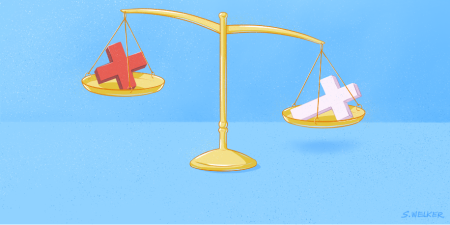Abstract
Experiencing homelessness is traumatizing and can exacerbate mental illnesses and substance use disorders. When persons experiencing homelessness are a danger to themselves or others, petitioning for involuntary placement is clinically, ethically, and legally indicated. The process of involuntary commitment is often traumatic and can fracture already fragile relationships that persons experiencing homeless have; involuntary commitment should be used only when necessary. It is society’s obligation to prevent crises but, when needed, to support persons in crisis by responding with care to their health needs.
Mental Illness and Homelessness
There are complex, multidirectional relationships among homelessness, mental illness, substance use disorder (SUD), and trauma. Serious mental illness (SMI) and SUD can compromise patients’ insight, perception, cognition, and behavior in ways that make it difficult for them to maintain housing, employment, and relationships. Both financial and behavioral implications of SUD can lead to homelessness,1 and those who experience the trauma of homelessness often use alcohol or drugs to self-medicate.2 One study showed that up to 68% of persons experiencing homelessness in childhood reported 4 or more adverse childhood events.3 Chronic injuries from physical trauma, such as traumatic brain injury, can generate cognitive and behavioral deficits, which also contribute to homelessness.4 Lack of affordable housing, loss of public support, SMI, SUD, or trauma history increase the likelihood that a person will experience homelessness.1 Deinstitutionalization during the US civil rights era also contributed to an epidemic of homelessness among persons with SMI,5 whose health is compromised by lack of community housing and rehabilitation policy and overreliance on incarceration for housing.5 Upstream, not downstream, resources need to be integrated into the health care system to address health, food, and shelter needs of persons experiencing homelessness.
Homelessness increases marginalization and decreases access to health care services.6 Meeting day-to-day survival needs (eg, food, shelter, hygiene) can delay health care seeking. Even when health care is accessed, medications can be lost or stolen or an individual’s capacity to manage some side effects of medication can be compromised by housing instability. Access to medication is also compromised when insurance or employment is lost or when an individual’s ability to renew Medicaid is undermined by not having a stable location for receipt of documents. Untreated and undertreated SMIs have devastating effects on persons experiencing homelessness. Suicidal ideation is 10 times more common among people experiencing homelessness than in the general population.7 Hospitalizations for SMI and SUD are almost 3 times as frequent among persons without than with stable housing (52% vs 18%).8
Involuntary Health Interventions
Persons experiencing homelessness are more likely to be involuntarily committed, a process that is chaotic and traumatic, exemplifies loss of control, and contributes to negative encounters with health care organizations and professionals. The American Psychiatric Association describes a person for whom involuntary interventions might be indicated as follows9:
- A person who has a severe mental disorder that “substantially impairs” thought, emotional process, judgment, or perception of reality or that “substantially impairs” behavior.
- A person who is in need of treatment in order to prevent relapse or deterioration that would cause the person to become a danger to themselves or others or to become unable to care for themselves.
- A person who, because of their mental illness, is unlikely to voluntarily seek or adhere to treatment.
- A person who has been committed to a mental health facility in the past 2 years who has not been able to adhere to treatment on their own on more than 1 occasion.
- A person whose condition is likely to improve with a well-planned, monitored course of treatment.
- A person for whom the clinician responsible for treatment has agreed to accept the patient and treatment plan.
Most commonly, people are not petitioned until they meet the standard of being a danger to self or others—that is, they are actively suicidal or homicidal with a plan, intention, and means, or they are unable to keep safe (eg, are unsheltered in subzero temperatures with inadequate clothing and protection or are prevented from seeking shelter by disorganized thoughts, perceptions, and delusions). Although homelessness alone is not a reason to involuntarily commit someone, being a danger to self or others warrants involuntary petition regardless of housing status.
People experiencing homelessness are consistently let down by resource-strapped health care systems.
There are times when clinicians have no option but to petition for involuntary outpatient or inpatient care to keep a patient or others safe. It is at such times that committing a person by force can be the most compassionate thing to do for a patient. However, since involuntary commitment is a kind of force commonly used in health care, this decision must be carefully deliberated upon by an admitting clinician. A decision to use interventions that limit the liberty of a person whose agency and options are already restricted by homelessness can cause that person to distrust the health care system even more, especially when that person refuses care. Clinicians can be tempted to assume that such patients, especially those with SUD or those who make decisions against clinicians’ advice, do not have decision-making capacity,10 but this is not always the case. People experiencing homelessness are consistently let down by resource-strapped health care systems. When patients have no surrogate decision maker or are otherwise unrepresented, as can be the case for persons experiencing homelessness who lack decision-making capacity, clinicians are ethically obligated not only to minimize the harms of using force (eg, trauma, humiliation, undermined self-determination),11 but also to respond to patients with compassion and regard for their dignity in order to preserve the therapeutic capacity of the patient-clinician relationship. Clinicians should consider that committing a patient by force to optimize the patient’s condition can also improve the patient’s capacity for autonomous decision making.12 While patients are being treated for their condition, force can be used to change medication regimens or other aspects of their care that make them unable to make decisions for themselves.
Four Ways to Meet Needs
Low-barrier, comprehensive, prevention-based interventions and shelter for persons experiencing homelessness are in short supply. Better alignment of food and shelter agencies’ services with health care can help persons experiencing homelessness manage their illnesses and cope with numerous stresses and can prevent acute exacerbations of mental illness and crises that tend to lead to involuntary interventions’ need and use in the course of care. Services should be trauma informed and integrated. While harm reduction has long been the standard of care, care should be delivered with compassion. Compassionate care can improve outcomes by enhancing autonomy, aligning with patients’ values, and maintaining patients’ long-term engagement in care.12
Training shelter staff in wellness. Although they are not often identified as such, shelter staff members are frontline health care workers, and community health workers and case managers have lived experience with caring about and for people experiencing homelessness.13 Providing shelter staff and street outreach workers with the basic tools to respond to food, shelter, hygiene, and health needs is critical. Programs such as Mental Health First Aid,14 Handle with Care®,15 and Crisis Prevention Institute16 are models of integrated care coordination.17 The more shelter staff seek to meet the physical and behavioral health of needs of individuals they serve, the better positioned will be organizations to advocate for the policy-level interests of persons experiencing homelessness.
Trauma-informed care. Trauma-informed care recognizes the health influences of trauma throughout the lifespan. Frontline health care workers should be educated in trauma-informed, patient-centered care that incorporates safety, choice, collaboration, and peer support to help avert crises.18
Compassion maximization, not just harm reduction. Harm reduction is not only relevant in cases in which care of a patient requires forced intervention; it is also a public health approach to minimizing population-based negative health outcomes. Harm reduction interventions (eg, needle exchange programs, naloxone, condoms, safe use sites, low-barrier shelters), along with improving food availability and choice and meeting basic comfort needs, are foundational to compassion, equity, public health, and good patient care. Harm reduction interventions keep people alive, engage them in services, and prevent destabilization19 and thus must be expanded to support clinicians’, organizations’, and professions’ obligations to express compassion to persons experiencing homelessness. While forcing treatment can lead to improved outcomes, it must be done with compassion and communication. These 2 variables are key to adherence to health care treatment plans, trust between clinician and patient, and patient autonomy.12
Care coordination. The programs named above involve teams offering services that help connect patients to programs for housing, mental health care, primary care, and medication-assisted treatment for SUD. Often referred to as “wrap-around” services, these services, when well coordinated, support patients’ autonomy, reduce the likelihood of the need for involuntary interventions, contribute to housing stability, and promote wellness.20
References
- Doran KM, Ran Z, Castelblanco D, Shelley D, Padgett DK. “It wasn’t just one thing”: a qualitative study of newly homeless emergency department patients. Acad Emerg Med. 2019;26(9):982-993.
-
Self-medication among homeless populations with substance use disorders. Substance Abuse and Mental Health Services Administration. Updated April 24, 2019. Accessed July 29, 2021. https://www.samhsa.gov/homelessness-programs-resources/hpr-resources/homeless-populations-self-medicate
- Radcliff E, Crouch E, Strompolis M, Srivastav A. Homelessness in childhood and adverse childhood experiences (ACEs). Matern Child Health J. 2019;23(6):811-820.
- Stone B, Dowling S, Cameron A. Cognitive impairment and homelessness: a scoping review. Health Soc Care Community. 2019;27(4):e125-e142.
- Yohanna D. Deinstitutionalization of people with mental illness: causes and consequences. Virtual Mentor. 2013;15(10):886-891.
-
Institute of Medicine. Access to health care services for homeless people. In: Homelessness, Health, and Human Needs. National Academy Press; 1988:chap 4.
- Patterson AA, Holden RR. Psychache and suicide ideation among men who are homeless: a test of Shneidman’s model. Suicide Life Threat Behav. 2012;42(2):147-156.
- Wadhera RK, Choi E, Shen C, Yeh RW, Joynt Maddox KE. Trends, causes, and outcomes of hospitalizations for homeless individuals: a retrospective cohort study. Med Care. 2019;57(1):21-27.
-
American Psychiatric Association. Resource document on involuntary outpatient commitment and related programs of assisted outpatient treatment. October 20, 2015. Accessed December 10, 2020. https://smiadviser.org/wp-content/uploads/2019/07/Resource-document-on-Involuntary-outpatient-commitment-2015-10-20.pdf
-
Miller D, Earley P, Hanson A. Committed: The Battle over Involuntary Psychiatric Care. John Hopkins University Press; 2018.
-
Melamed Y, Fromer D, Kemelman Z, Barak Y. Working with mentally ill homeless persons: should we respect their quest for anonymity? J Med Ethics. 2000;26(3):175-178.
-
Trestman RL, Nagaraja K. How should clinicians execute critical force interventions with compassion, not just harm minimization, as a clinical and ethical goal? AMA J Ethics. 2021;23(4):E292-E297.
-
National Health Care for the Homeless Council. Integrating community health workers into primary care practice: a resource guide for HCH programs. July 2016. Accessed December 12, 2020. https://nhchc.org/wp-content/uploads/2019/08/chw-resource-guide-pdf-final.pdf
-
Research and evidence base. Mental Health First Aid. Accessed June 22, 2021 https://www.mentalhealthfirstaid.org/about/research
-
Statistics. Handle With Care®. Accessed June 22, 2021. https://handlewithcare.com/statistics/
-
Metrics that matter: measuring the impact of Nonviolent Crisis Intervention® training. Crisis Prevention Institute. Accessed June 22, 2021. https://www.crisisprevention.com/CPI/media/Media/Resources/research/Metrics-That-Matter.pdf
-
Dieterich M, Irving CB, Bergman H, Khokhar MA, Park B, Marshall M. Intensive case management for severe mental illness. Cochrane Database Syst Rev. 2017;1(1):CD007906.
-
Substance Abuse and Mental Health Services Administration. Trauma-informed care: a sociocultural perspective. In: Trauma-Informed Care in Behavioral Health Services. Treatment Improvement Protocol (TIP) Series 57. HHS publication (SMA) 13-4801. Substance Abuse and Mental Health Services Administration; 2014:chap 1. Accessed April 29, 2021. https://store.samhsa.gov/sites/default/files/d7/priv/sma14-4816.pdf
-
What is harm reduction? Harm Reduction International. Accessed December 12, 2020. https://www.hri.global/what-is-harm-reduction
-
Substance Abuse and Mental Health Services Administration. Behavioral Health Services for People Who Are Homeless. Treatment Improvement Protocol (TIP) Series 55. HHS publication (SMA) 13-4734. Substance Abuse and Mental Health Services Administration; 2013. Accessed April 30, 2021. https://store.samhsa.gov/sites/default/files/d7/priv/sma13-4734.pdf



